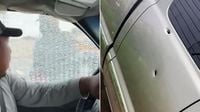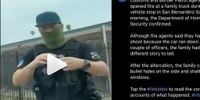On a quiet Saturday morning in San Bernardino, California, what began as a routine drive for a local family exploded into chaos, confusion, and gunfire. The events that unfolded on August 16 and 17, 2025, have since sparked widespread debate about federal immigration enforcement, the use of force, and the delicate balance between public safety and civil rights. The incident, which was caught on cellphone video and quickly went viral, has left the family at the center of the storm shaken, federal agencies defending their actions, and local advocates demanding answers.
According to reports from NBC and CNN, the confrontation began when masked federal agents—identified as Customs and Border Protection (CBP) officers—surrounded a family’s truck during what the Department of Homeland Security (DHS) later called a "targeted enforcement operation." The agents, some wearing tactical vests marked "police" and at least one with a hat labeled "CBP," approached the vehicle with weapons drawn. Cellphone videos recorded from inside the truck show the tense moments as the family, confused and frightened, repeatedly asked the agents to show identification. The agents, however, did not comply with these requests.
Martin, one of the three men inside the vehicle, described the ordeal to KABC, a CNN affiliate. "Once the glasses were shattered, my father-in-law, fearing for his life from his perspective … he drove the vehicle away from where those agents were at," Martin recalled. The agents had demanded that the driver, later identified as Francisco, exit the vehicle. When Francisco refused, the agents smashed two windows of the truck in an attempt to gain access.
At that moment, Francisco made a split-second decision. He hit the gas, attempting to escape what he perceived as an immediate threat. As the truck accelerated away, three loud pops—later confirmed by both DHS and the San Bernardino Police Department as gunshots—rang out. Bullet holes were later observed in the side of the truck, and Martin told KABC, "Thank God the bullets didn’t go through the truck. They just went in, got stuck into the door, but they were aimed at my brother-in-law, who was in the passenger front."
After fleeing the scene, the family called local police to report that masked men had opened fire on their vehicle. The confusion was palpable, as the agents had not presented any judicial warrants or official identification during the stop. The family’s fear was compounded by the fact that the agents were masked and the vehicles they arrived in were unmarked.
DHS, for its part, issued a statement defending the agents’ actions. According to DHS, the agents were acting in self-defense after Francisco allegedly drove his vehicle at officers, striking two CBP agents. "Because of the subjects forcing a CBP officer to discharge his firearm in self-defense," DHS stated, emphasizing that the shooting was justified under the circumstances. The agency did not specify the severity of the officers’ injuries, and cellphone footage did not capture the exact moment of the alleged assault.
The incident did not end with the shooting. About an hour after the initial stop, a new chapter unfolded at the family’s home. Armed immigration and Homeland Security agents, accompanied by San Bernardino police, surrounded the residence from approximately 9:30 a.m. to 3:45 p.m., according to the Inland Coalition for Immigrant Justice. The organization said the agents never presented a warrant but pressured the family to come outside, creating what they described as a climate of fear. "This is a clear abuse of power. Firing at civilians, detaining families without cause, and silencing community voices is unacceptable and must end," the group said in a statement to CNN.
DHS later clarified that local police had briefly taken the subject—presumably Francisco—into custody but released him. The agency criticized this decision, attributing it to California’s pro-sanctuary policies, which they argue shield criminals instead of protecting communities. "This decision was made despite the subject refusing to comply and wounding two officers—another terrible example of California’s pro-sanctuary policies in action," DHS said. The San Bernardino Police Department, however, cited the California Values Act, which restricts local law enforcement from assisting federal officials with immigration enforcement actions. Police told KABC they only returned to the scene later after a request from federal officials, as a large crowd had gathered during federal attempts to arrest a man wanted for assaulting a federal officer. Whether the man was ultimately taken into custody remains unclear.
For the family, the trauma of the incident is still fresh. Francisco, speaking to NBC Los Angeles, expressed his disbelief and frustration: "I had to protect my life and my family. My truck was shot three times." His son-in-law Martin echoed these sentiments, saying, "It’s just upsetting that it happened to us. I am glad my brother is okay, Pop is okay, but it’s just not cool that [immigration enforcement officials are] able to do something like that." The Inland Coalition for Immigrant Justice has since mobilized to provide legal support for the family, highlighting the ongoing tension between immigrant communities and federal enforcement agencies.
The incident has reignited debate over the use of force by federal agents, the transparency of immigration enforcement operations, and the rights of individuals during encounters with law enforcement. Advocates argue that the lack of identification and warrants, combined with the use of firearms in a residential neighborhood, points to a troubling escalation. Federal officials, meanwhile, maintain that their agents acted appropriately under threat and that local policies are hampering their ability to enforce the law.
As investigations continue and calls for accountability grow louder, the San Bernardino case stands as a stark reminder of the complexities and human costs that can arise when federal immigration enforcement collides with local communities. The videos, statements, and aftermath have left more questions than answers, but one thing is clear: the reverberations from that Saturday morning will not soon fade.

